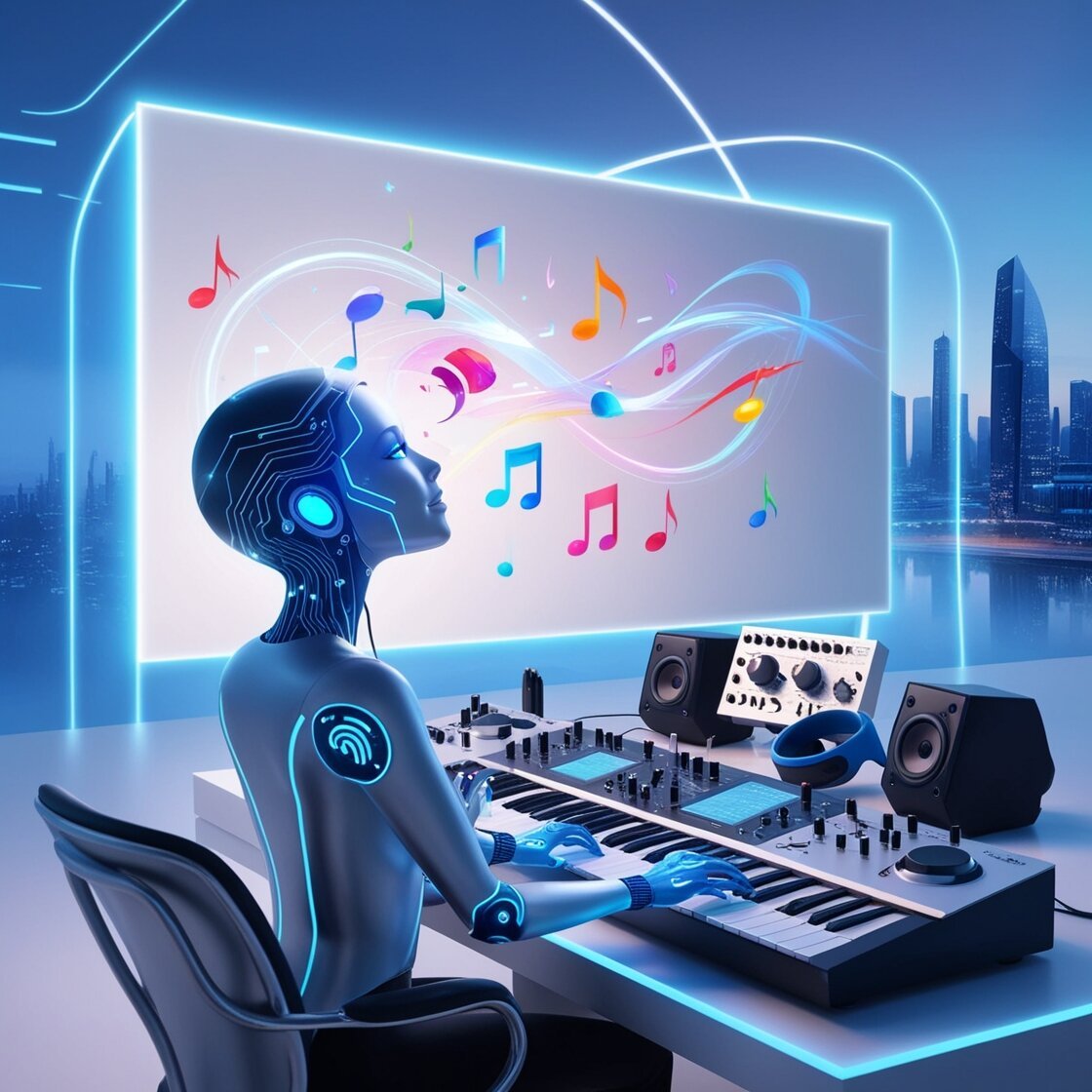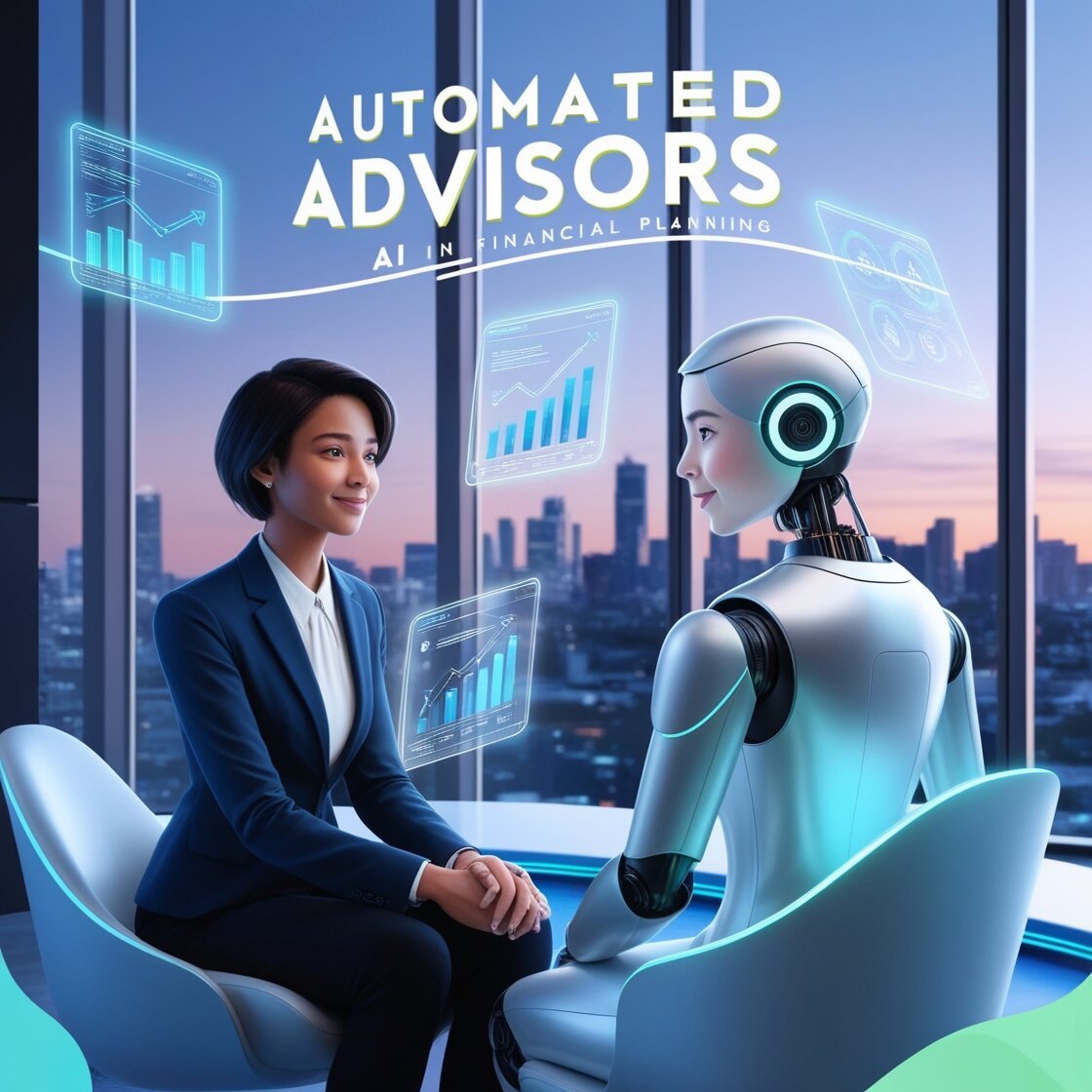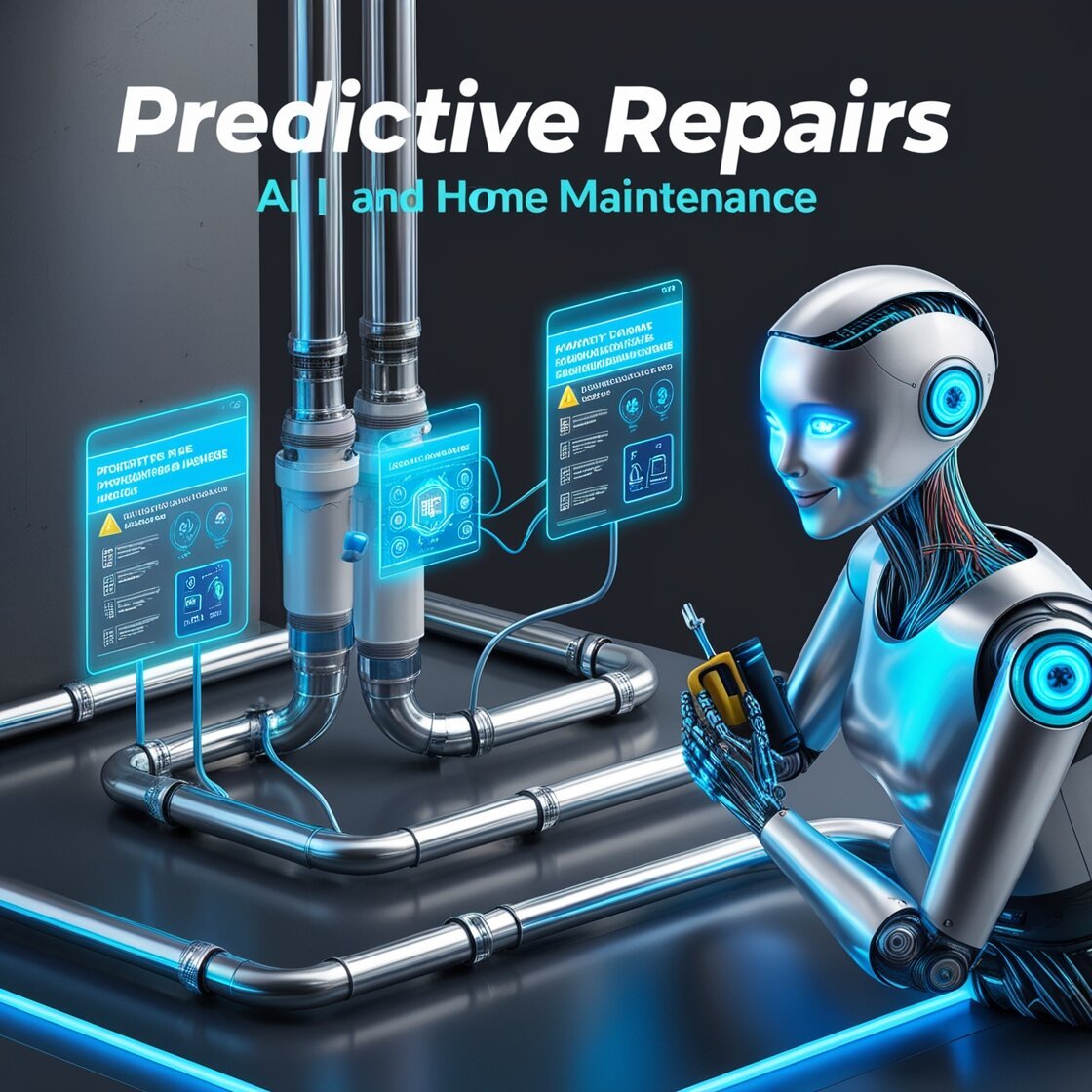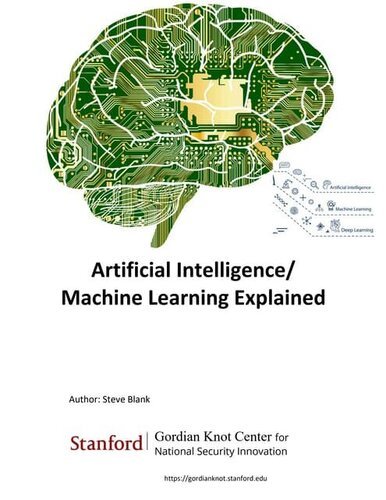
-
AI in Entertainment Creating New Music and Art
The Rise of AI in the Creative WorldArtificial intelligence (AI) is reshaping the entertainment industry, driving innovation in music and art. From composing unique melodies to generating breathtaking visual art, AI is a game-changer. By merging technology and creativity, it’s unlocking new horizons for artists and audiences alike. AI in Music CompositionTransforming Music CreationAI-powered tools like AIVA and Amper Music enable musicians to compose original tracks effortlessly. These platforms use machine learning algorithms to analyze vast datasets of musical styles, creating compositions tailored to specific needs. Whether for film scores or personal projects, AI helps musicians save time and explore uncharted territories. Enhancing Music ProductionIn music production, AI simplifies processes like mixing and mastering. Tools like LANDR and iZotope employ advanced algorithms to refine audio tracks, ensuring professional-quality sound. AI also assists in generating loops and beats, allowing artists to focus on creative expression. AI’s Role in Visual ArtCreating Stunning Digital ArtAI programs like DALL•E and DeepArt are revolutionizing digital art creation. These tools generate unique visuals based on textual inputs, offering endless possibilities for artists and designers. AI art challenges traditional methods, pushing the boundaries of creativity. Restoring and Preserving ArtAI is instrumental in restoring damaged artwork and preserving cultural heritage. By analyzing historical patterns and colors, AI restores art to its original glory. This technology ensures that masterpieces withstand the test of time for future generations. Collaboration Between Humans and AIAugmenting CreativityAI serves as a collaborator, not a replacement, for human creativity. Artists leverage AI to gain new perspectives and experiment with novel ideas. This partnership enhances artistic expression, combining the best of human ingenuity and machine precision. Customizing Artistic ExperiencesAI enables personalized experiences for audiences. For instance, Spotify and YouTube use AI to curate music and video recommendations based on user preferences. This tailored approach enhances user engagement and satisfaction. Challenges and Ethical ConsiderationsNavigating Copyright IssuesAI-generated art raises questions about ownership and copyright. Establishing clear guidelines is essential to protect artists’ rights while fostering innovation. Maintaining AuthenticityBalancing AI’s influence with human authenticity is crucial. Over-reliance on AI could dilute the emotional depth that defines art. Striking this balance ensures meaningful creative outputs. The Future of AI in EntertainmentThe potential of AI in music and art is boundless. As technology evolves, it will continue to inspire and empower artists, transforming the creative landscape. By embracing AI, the entertainment industry can explore new realms of artistic expression and redefine the boundaries of creativity. AI is not just a tool; it’s a catalyst for artistic evolution. From composing symphonies to crafting digital masterpieces, its impact is undeniable. As we move forward, the synergy between humans and AI will shape the future of art and music.
-
NeoAdmin changed their profile photo
-
AI and Home Renovation: Planning and Visualization
Revolutionizing Home Renovation with AIArtificial Intelligence (AI) is transforming the way homeowners approach renovations. From planning to visualization, AI provides cutting-edge tools that simplify the process. With smart solutions, you can now make informed decisions and turn your dream projects into reality. AI-Powered Design ToolsOne of the standout features of AI in home renovation is its design tools. These platforms use algorithms to generate layouts based on your preferences. Upload a photo of your space, and AI creates tailored suggestions. This saves time and ensures designs match your style and needs. 3D Visualization Made SimpleVisualizing changes is often challenging. AI addresses this by offering 3D rendering tools. You can explore potential designs in a realistic environment. This immersive experience helps you decide on layouts, colors, and furniture placement with confidence. Custom RecommendationsAI learns from your inputs and provides personalized recommendations. Whether you prefer modern, minimalist, or rustic designs, the technology adapts to your taste. It ensures every detail aligns with your vision, down to the color palette and textures. Streamlined Project PlanningPlanning is the backbone of any renovation. AI simplifies this process by breaking down tasks and estimating costs. Using AI, you can create timelines, budget effectively, and avoid unexpected expenses. Accurate Cost EstimationAI tools analyze material prices, labor costs, and project scope to deliver precise estimates. This transparency ensures you stay within budget while achieving high-quality results. Smart SchedulingEfficient project management is essential. AI-generated schedules optimize timelines by considering contractor availability and delivery times. This reduces delays and keeps your renovation on track. Energy Efficiency and SustainabilityHome renovations today prioritize eco-friendliness. AI supports sustainability by identifying energy-efficient solutions. It suggests materials and designs that reduce environmental impact while enhancing your home’s functionality. Green Material SuggestionsAI algorithms recommend sustainable materials like bamboo flooring or recycled wood. These options align with modern green building standards. Optimized Energy UsageFrom solar panel placement to smart thermostats, AI designs solutions that lower utility bills. This makes your home not only stylish but also environmentally responsible. Virtual Reality IntegrationAI integrates with virtual reality (VR) to enhance the renovation experience. VR allows you to "walk through" your redesigned space before construction begins. This interactive tool ensures you’re completely satisfied with the final plan. Enhanced Collaboration with ContractorsAI improves communication between homeowners and contractors. Sharing AI-generated designs and plans ensures everyone is on the same page. This minimizes errors and ensures smooth execution. Conclusion: The Future of RenovationAI is revolutionizing home renovation, making it more efficient, cost-effective, and enjoyable. From 3D visualizations to sustainable solutions, these tools empower homeowners to bring their visions to life effortlessly. Embrace AI for your next renovation project and experience the transformation firsthand.
-
Discover how AI-powered smart devices enhance pet care with monitoring, feeding, and activity tracking solutions.
Revolutionizing Pet Care with Smart TechnologySmart devices are transforming pet care, making it easier and more efficient for owners to keep their pets healthy and happy. From automated feeders to health trackers, technology now offers innovative solutions for every pet’s need. Automated Pet Feeders for Hassle-Free MealsFeeding your pet has never been simpler. Automated feeders allow you to schedule meals and control portions remotely. These devices ensure your pets are fed on time, even if you're away. Some models even include cameras for monitoring mealtime activities. Smart Collars for Health and SafetySmart collars are packed with features like GPS tracking and health monitoring. They help locate lost pets and provide real-time updates on your pet's activity levels, heart rate, and more. These collars are ideal for ensuring your furry friend stays safe and active. Interactive Toys to Keep Pets EngagedAI-powered interactive toys are perfect for entertaining pets when you're busy. These toys stimulate mental activity and prevent boredom by responding to your pet's movements and behavior. They are excellent tools for promoting physical and emotional well-being. Health Monitoring Devices for Better CareAdvanced health monitors track vital signs, sleeping patterns, and even hydration levels. These devices alert you to any unusual changes, enabling early detection of potential health issues. Regular monitoring ensures your pet remains in optimal health. Pet Cameras for Remote InteractionPet cameras allow owners to keep an eye on their pets while away. Equipped with two-way audio, these cameras enable you to talk to your pet and even dispense treats. Some models include motion detection to alert you of unusual activity. Smart Litter Boxes for a Cleaner HomeSmart litter boxes automatically clean themselves, reducing odor and maintenance. These devices use sensors to detect when your pet has used the box and clean up immediately after. They are a game-changer for cat owners seeking convenience. Voice-Controlled Assistants for Easy ManagementIntegrating smart pet devices with voice-controlled assistants like Alexa or Google Assistant makes managing pet care seamless. From setting reminders to activating devices, these assistants simplify daily tasks and save time. AI-Powered Training ToolsTraining tools equipped with AI help teach pets new commands and improve behavior. These devices offer personalized training programs and track your pet’s progress over time. Consistent training leads to better results and a stronger bond with your pet. Energy Efficiency in Smart DevicesMany smart pet devices are designed to be energy-efficient, reducing their environmental impact. Features like power-saving modes ensure that you can use these gadgets without worrying about high energy consumption. ConclusionSmart devices for pets are revolutionizing the way we care for our furry companions. By leveraging AI and innovative technology, these tools enhance convenience, safety, and overall well-being. Investing in these gadgets ensures a happier, healthier life for your pet and peace of mind for you.
-
AI in Financial Planning: Automated Advisors
What Are Automated Advisors?Automated advisors, or robo-advisors, are digital platforms using artificial intelligence (AI) to provide financial guidance. They help manage investments, allocate assets, and create personalized financial strategies. These tools reduce the need for traditional financial advisors, offering affordable, data-driven solutions. How Do Automated Advisors Work?Automated advisors use algorithms to analyze financial data. By evaluating user inputs such as income, goals, and risk tolerance, they suggest optimal investment strategies. These platforms continuously adjust recommendations based on market trends and user behavior. Key Features of Automated AdvisorsPortfolio Management: Tailored investment portfolios aligned with your goals. Cost Efficiency: Lower fees compared to traditional advisors. 24/7 Availability: Access to financial planning tools anytime. Data-Driven Insights: Accurate recommendations using advanced analytics. Advantages of Automated AdvisorsCost-Effective SolutionsAutomated advisors eliminate high advisory fees, making financial planning accessible to everyone. They charge minimal fees, ensuring greater returns for users. Personalized Financial PlansWith AI, automated advisors provide customized plans. These plans align with individual financial goals, offering a unique user experience. Real-Time AdjustmentsMarkets fluctuate, and so do investment needs. Automated advisors adapt strategies in real-time, ensuring optimal performance. Enhanced AccessibilityAvailable on multiple devices, these platforms cater to users worldwide. This ensures anyone can start investing with minimal effort. Limitations to ConsiderWhile efficient, automated advisors lack human intuition. They may not address complex financial scenarios. Additionally, relying solely on algorithms could pose risks during volatile markets. Who Should Use Automated Advisors?Beginners in InvestingNew investors benefit from easy-to-use platforms with guided instructions. Cost-Conscious IndividualsAutomated advisors are perfect for those seeking affordable financial planning. Tech-Savvy UsersUsers comfortable with technology find these platforms convenient and efficient. Future of Automated AdvisorsThe adoption of AI in financial planning continues to grow. Future advancements may include more intuitive platforms, better predictive analytics, and hybrid models combining human expertise with AI precision. ConclusionAutomated advisors revolutionize financial planning. They provide accessible, affordable, and efficient solutions for users of all experience levels. While not a complete replacement for human advisors, their role in simplifying investments is undeniable. Explore automated advisors today and take charge of your financial future!
-
AI and Home Maintenance: Predictive Repairs
Introduction to Predictive RepairsArtificial intelligence (AI) is transforming home maintenance. By analyzing data, it predicts when repairs are needed, saving time and money. Predictive repairs are reshaping how homeowners handle maintenance tasks. How AI Predicts Home RepairsAI systems use sensors and machine learning to monitor home systems. These devices collect real-time data, identifying potential issues before they escalate. For example, AI can detect unusual vibrations in HVAC systems, signaling a potential breakdown. Role of IoT in Predictive MaintenanceThe Internet of Things (IoT) powers predictive repairs. Smart devices, like thermostats and leak detectors, continuously gather data. This connectivity enables AI to offer precise maintenance recommendations. Benefits of Predictive Repairs for HomeownersCost SavingsPredictive repairs reduce expenses by catching problems early. Preventative action avoids costly emergency repairs. Increased Equipment LifespanRegular maintenance extends the life of home appliances. AI identifies wear and tear, ensuring timely interventions. Enhanced Energy EfficiencyAI helps maintain optimal appliance performance. Efficient systems lower energy consumption, cutting utility bills. Applications of Predictive Repairs in Modern HomesHVAC SystemsAI monitors heating and cooling systems for anomalies. It predicts filter replacements and potential mechanical issues. Plumbing SystemsLeak detection sensors alert homeowners to potential water damage. Predictive AI minimizes the risk of costly repairs. Electrical SystemsAI detects irregularities in electrical circuits. Early warnings prevent potential fire hazards and power outages. How to Implement Predictive Maintenance in Your HomeInvest in Smart DevicesInstall IoT-enabled devices to monitor appliances and systems. These devices provide the data AI needs for predictions. Choose AI-Integrated SolutionsOpt for home automation systems with predictive maintenance features. These platforms simplify monitoring and alerts. Partner with Professional ServicesWork with service providers offering AI-driven maintenance plans. Professionals can interpret AI insights for effective repairs. Future of AI in Home MaintenanceAI will continue evolving, offering more precise predictions. As technology advances, predictive repairs will become standard in modern homes. Automation and integration with emerging technologies will further enhance convenience. ConclusionAI-driven predictive repairs are revolutionizing home maintenance. They save money, extend equipment lifespan, and ensure energy efficiency. Investing in smart technology today prepares your home for a smarter, more reliable future.
-
AI in Fitness Trackers: Motivating Healthier Lifestyles
Introduction: The Rise of AI in Fitness Tracking AI-powered fitness trackers have transformed how people approach health and fitness. These smart devices combine advanced technology with user-friendly features, making it easier to achieve wellness goals. How AI Enhances Fitness TrackingPersonalized Health InsightsAI analyzes user data to deliver customized recommendations. From tracking steps to monitoring heart rate, AI ensures precise and actionable feedback tailored to individual needs. Accurate Data CollectionAI algorithms reduce errors in tracking. Advanced sensors measure metrics like calorie burn, sleep quality, and activity levels with impressive accuracy. Real-Time FeedbackWith AI, fitness trackers offer real-time coaching. Whether you’re running, cycling, or doing yoga, the device adapts to your pace and progress. Encouraging Consistency and MotivationGamification FeaturesAI integrates gamification elements like challenges, rewards, and leaderboards. These features keep users motivated and engaged. Daily Reminders and AlertsAI-powered trackers send reminders to move, hydrate, or complete workouts. This proactive approach promotes healthier habits. Virtual CoachingAI acts as a personal trainer. It provides workout recommendations and adjusts routines based on performance, ensuring continual improvement. Tracking Beyond FitnessSleep MonitoringAI tracks sleep patterns and offers tips to improve sleep quality. A good night’s rest is crucial for overall health. Stress ManagementSome fitness trackers use AI to detect stress levels through heart rate variability. They suggest breathing exercises to promote relaxation. Dietary RecommendationsBy analyzing activity levels and goals, AI can recommend daily calorie intake and nutritional adjustments. Benefits of AI-Driven Fitness TrackersUser-Friendly ExperienceAI simplifies fitness tracking with intuitive interfaces. Even beginners can navigate and use the features effectively. Improved Health OutcomesBy promoting consistency, these trackers lead to better long-term health results. Users can monitor progress and stay accountable. Data SecurityModern fitness trackers prioritize user privacy. Encrypted data storage ensures personal health information stays secure. Future of AI in Fitness TrackingThe future of AI in fitness trackers is promising. Innovations like predictive analytics, advanced health sensors, and seamless integration with other devices are on the horizon. These advancements will further enhance user experience and health outcomes. Conclusion: A Healthier Future with AI AI in fitness trackers is reshaping the way we pursue fitness and well-being. By delivering personalized insights, motivating healthier habits, and expanding tracking capabilities, these devices empower users to lead healthier lifestyles.
-
AI in the Classroom: Enhancing Learning for Students
Artificial Intelligence (AI) is revolutionizing education. By integrating AI tools into classrooms, educators enhance student learning experiences. These technologies personalize education, cater to diverse learning styles, and create dynamic environments. Personalized Learning with AIAI customizes learning experiences. Tools like adaptive learning platforms analyze individual student performance, tailoring lessons to their needs. This ensures that students progress at their own pace, boosting confidence and understanding. Efficient Classroom ManagementTeachers save time with AI-powered administrative tools. Automated grading systems, attendance tracking, and lesson planning allow educators to focus on teaching. These innovations streamline classroom management and reduce workloads. Interactive and Engaging ToolsAI introduces interactive tools like chatbots and virtual reality simulations. These applications make learning engaging, fostering creativity and critical thinking. Students explore complex concepts in an immersive and exciting way. Bridging Learning GapsAI identifies and addresses learning gaps. By analyzing student performance, AI suggests targeted interventions to improve understanding. This helps struggling students catch up and excel. Enhanced Accessibility for All LearnersAI ensures inclusivity by assisting students with disabilities. Text-to-speech tools, language translation apps, and visual aids make learning accessible. These tools break down barriers, creating equal opportunities for all. Real-Time Feedback and AssessmentInstant feedback from AI tools enhances learning. Students receive immediate insights into their performance, allowing them to correct mistakes and improve. Teachers also gain valuable data to adjust teaching methods effectively. Preparing Students for the FutureAI equips students with essential skills for the future. By interacting with AI tools, students develop problem-solving abilities, adaptability, and tech proficiency. These skills are vital for thriving in a technology-driven world. Challenges and Ethical ConsiderationsWhile AI offers many benefits, challenges exist. Data privacy, equity in access, and over-reliance on technology require careful attention. Educators must balance AI integration with traditional teaching methods to ensure holistic learning. ConclusionAI in the classroom is transforming education. By personalizing learning, improving accessibility, and fostering engagement, it creates opportunities for students and teachers alike. With thoughtful implementation, AI paves the way for a brighter educational future.
-
AI in Real Estate: Smart Home Searches and Virtual Tour
Artificial Intelligence (AI) is transforming the real estate industry. From simplifying property searches to enhancing virtual tours, AI is making home buying and selling easier than ever. Let's explore how AI is changing the landscape of real estate. Streamlined Property SearchesAI-powered platforms use advanced algorithms to analyze user preferences. These tools recommend properties based on factors like budget, location, and amenities. This personalized approach saves time and improves the overall search experience. Enhanced Search AccuracyMachine learning algorithms process vast amounts of data. They identify trends and predict market behavior, ensuring users find properties that match their exact requirements. This precision helps buyers make informed decisions quickly. Smart Filters and CustomizationModern real estate platforms offer smart filters. These allow users to refine their searches by criteria such as proximity to schools, green spaces, or public transport. AI ensures these filters provide accurate and up-to-date results. Virtual Tours: A Game-ChangerAI has made virtual tours a staple in real estate. These immersive experiences let buyers explore properties from the comfort of their homes. 3D Mapping and Augmented RealityWith 3D mapping and augmented reality (AR), virtual tours provide detailed property views. Buyers can visualize layouts, inspect interiors, and even plan renovations without visiting the site. Real-Time InteractivityInteractive tours powered by AI allow users to ask questions and receive instant answers. They can zoom in on specific features or request additional images, enhancing their understanding of the property. Predictive Market InsightsAI tools analyze historical data to forecast market trends. These insights help buyers and sellers make strategic decisions. Price PredictionsBy examining factors like neighborhood trends and economic indicators, AI predicts property values. This information empowers buyers to negotiate better deals and sellers to price their properties competitively. Demand AnalysisAI evaluates buyer preferences and demand patterns. Real estate agents can use this data to target their listings effectively, ensuring faster sales. Improving Customer ExperienceAI-driven chatbots and virtual assistants enhance communication between agents and clients. They provide instant responses and schedule viewings, streamlining the entire process. 24/7 AvailabilityChatbots are available around the clock to answer queries. This ensures no lead is missed, improving customer satisfaction and conversion rates. Personalized RecommendationsAI tracks user behavior to offer tailored property suggestions. This keeps potential buyers engaged and increases the likelihood of a sale. Future of AI in Real EstateThe integration of AI in real estate is just beginning. Innovations like predictive maintenance, smart contracts, and AI-driven marketing campaigns promise to redefine the industry further. Sustainable PracticesAI encourages eco-friendly construction by analyzing sustainable building materials and designs. This aligns with the growing demand for green homes. Blockchain IntegrationAI combined with blockchain ensures secure transactions. It reduces fraud and streamlines property transfers, making the process more efficient. Conclusion: Embracing AI for Better ResultsAI is revolutionizing real estate by improving search accuracy, enhancing virtual tours, and providing market insights. It’s reshaping the industry for buyers, sellers, and agents alike. As technology advances, the future of real estate looks smarter and more efficient than ever.
-
The Beginners Guide to Artificial Intelligence AI
- 5 downloads
- Version 1.0.0
In the rapidly evolving field of AI, staying up-to-date is essential. Even experienced AI professionals recognize the importance of continuous learning to avoid falling behind. New trends, algorithm updates, and technological breakthroughs are just a few things every AI expert should monitor. If you haven’t been keeping track for any reason, don't worry—we’ve got you covered.Free -
AI in Energy Management: Smart Grids and Home Efficiency
Artificial Intelligence (AI) is revolutionizing energy management systems worldwide. By integrating AI, smart grids and homes can optimize energy usage, reduce costs, and improve sustainability. Smart Grids: The Backbone of Intelligent Energy DistributionHow AI Enhances Smart GridsAI enables predictive analytics, allowing grids to anticipate energy demand and supply fluctuations. This proactive approach minimizes power outages and ensures a balanced distribution of energy. Real-Time Monitoring and ControlSmart grids equipped with AI analyze real-time data to adjust energy flow dynamically. These systems detect anomalies, ensuring efficient power delivery while reducing wastage. Renewable Energy IntegrationAI simplifies the integration of renewable energy sources, such as solar and wind. It predicts generation patterns, ensuring seamless incorporation into the grid without disrupting supply. AI-Powered Home EfficiencyOptimizing Energy Consumption at HomeAI-driven home automation systems monitor electricity usage, suggesting ways to cut down consumption. Smart thermostats, lights, and appliances adjust based on user behavior, saving energy and costs. Energy-Saving Algorithms in ActionAI uses advanced algorithms to analyze household energy patterns. It recommends optimal settings for appliances and detects devices consuming excessive power. Personalized RecommendationsSmart home systems learn individual preferences, providing tailored energy-saving tips. From adjusting temperatures to scheduling appliance use, AI ensures maximum efficiency. Environmental and Economic BenefitsReducing Carbon FootprintsAI-powered energy management significantly reduces carbon emissions. By promoting renewable energy and minimizing wastage, these systems contribute to a cleaner environment. Cost Savings for ConsumersSmart energy systems lower electricity bills by optimizing usage patterns. Additionally, they enable consumers to sell excess renewable energy back to the grid, further reducing costs. Challenges and Future ProspectsAddressing Data Privacy ConcernsAs AI systems collect vast amounts of data, privacy concerns arise. Ensuring secure and transparent data handling is crucial for widespread adoption. Expanding AI CapabilitiesThe future holds immense potential for AI in energy management. Continuous advancements will make systems smarter, more efficient, and accessible to all households. ConclusionAI is transforming energy management through smart grids and home efficiency solutions. With its ability to optimize energy use, reduce costs, and promote sustainability, AI is paving the way for a greener future. Embracing these innovations can empower individuals and organizations to achieve energy efficiency like never before.
-
AI in Public Transportation: Optimizing Routes and Schedules
Artificial Intelligence (AI) is transforming public transportation by enhancing efficiency and reliability. By integrating AI, transit systems are optimizing routes and schedules, improving the commuter experience. Benefits of AI in Public Transportation AI in public transportation brings numerous benefits. It reduces travel time and minimizes delays. Furthermore, it enhances route planning and schedule management, leading to a more reliable service. Optimizing Routes with AI AI-driven systems analyze vast amounts of data to optimize routes. By considering traffic patterns, passenger density, and historical data, AI suggests the most efficient routes. This reduces congestion and improves travel time. Enhancing Schedule Management AI helps in precise schedule management. By analyzing real-time data, AI adjusts schedules dynamically to accommodate unexpected delays. This ensures timely service and enhances passenger satisfaction. Predictive Maintenance AI enables predictive maintenance, reducing downtime. By monitoring the condition of vehicles and infrastructure, AI predicts potential issues before they become critical. This proactive approach ensures continuous service. Improving Passenger Experience AI enhances the passenger experience by providing real-time updates and personalized travel information. Passengers receive accurate information on arrival times, delays, and alternative routes, making their journey smoother. Case Studies Several cities have successfully implemented AI in their transit systems. For example, London and Singapore have seen significant improvements in efficiency and passenger satisfaction. These case studies highlight the potential of AI in revolutionizing public transportation. Challenges and Solutions Implementing AI in public transportation is not without challenges. Data privacy concerns and the need for significant investment are major hurdles. However, these challenges can be addressed through robust data security measures and strategic planning. Future of AI in Public Transportation The future of AI in public transportation looks promising. As technology advances, we can expect even more sophisticated systems that further enhance efficiency and reliability. Continuous innovation will drive the evolution of smart transit systems. Conclusion AI is a game-changer for public transportation. By optimizing routes and schedules, it improves efficiency, reduces travel time, and enhances the overall commuter experience. Embracing AI in transit systems is essential for creating smarter, more reliable public transportation networks.
-
Maximizing Online Income: Harnessing AI and PTC Websites for Profitable Strategies
Maximizing Earnings with AI and PTC Websites Introduction to AI and PTC Websites Artificial Intelligence (AI) and Paid-to-Click (PTC) websites offer numerous opportunities for online earnings. These platforms can transform how you generate income online, providing both efficiency and profitability. Understanding their potential can help you tap into a steady revenue stream. The Role of AI in Online Earnings AI has revolutionized the way we approach online earning strategies. By leveraging machine learning algorithms and data analytics, AI can optimize your online activities for better results. For example, AI can analyze user behavior on your website, helping you target ads more effectively and boost conversion rates. How PTC Websites Work PTC websites pay users for clicking on ads and visiting websites. These platforms act as intermediaries between advertisers and users. Advertisers pay for clicks, while users earn a small fee for each click they make. The simplicity of this model makes PTC websites an attractive option for those looking to earn extra money online. Combining AI with PTC Websites for Maximum Profit Integrating AI with PTC websites can significantly enhance your earning potential. AI tools can help you identify the most profitable PTC sites, track your earnings, and optimize your clicking patterns. Additionally, AI can assist in automating repetitive tasks, allowing you to focus on high-value activities. Benefits of Using AI in PTC Earnings Increased Efficiency: AI can automate tasks, saving you time and effort. Data-Driven Insights: AI provides valuable insights into your earning patterns and potential improvements. Optimized Earnings: By analyzing trends and behaviors, AI can help you maximize your profits. Enhanced User Experience: AI can personalize your interactions, making the earning process more engaging and effective. Choosing the Right PTC Websites Selecting the right PTC websites is crucial for maximizing your earnings. Look for sites with high user ratings, reliable payment systems, and a wide range of ad options. Research and compare different platforms to find the ones that best suit your needs and preferences. Tips for Maximizing PTC Earnings with AI Use AI Tools: Utilize AI-based tools to automate clicks and optimize your earning strategy. Track Your Performance: Regularly monitor your earnings and adjust your strategies based on data insights. Stay Updated: Keep abreast of new AI technologies and PTC platforms to stay competitive. Diversify Your Activities: Engage with multiple PTC sites to diversify your income streams and reduce risk. Potential Challenges and Solutions While combining AI and PTC websites can be highly profitable, it’s not without challenges. Some users may face issues with AI tool compatibility or encounter fraudulent PTC sites. To mitigate these risks, always verify the legitimacy of PTC platforms and ensure your AI tools are up-to-date and compatible. Conclusion: Embrace the Future of Online Earnings Incorporating AI into your PTC website strategy can unlock significant earning potential. By leveraging advanced technology and smart strategies, you can maximize your online income with minimal effort. Embrace these tools and stay ahead in the ever-evolving landscape of online earnings.
-
AI in Travel Planning: Personalized Itineraries
Transforming Travel with AIIn today's fast-paced world, AI has revolutionized travel planning. Gone are the days of one-size-fits-all itineraries. AI offers personalized travel experiences, ensuring every journey is unique and tailored to individual preferences. Personalized Itineraries with AIUnderstanding Traveler PreferencesAI algorithms analyze vast amounts of data to understand traveler preferences. By considering past trips, search history, and social media activity, AI can predict what a traveler might enjoy. This ensures that each itinerary is not only customized but also highly relevant. Real-Time Updates and AdjustmentsOne of the key benefits of AI in travel planning is its ability to provide real-time updates. If there are changes in weather, flight schedules, or local events, AI can quickly adjust the itinerary. This flexibility ensures a smooth travel experience, minimizing disruptions. Enhancing Travel ExperiencesOptimizing Travel RoutesAI can optimize travel routes, reducing travel time and costs. By analyzing traffic patterns, flight paths, and public transportation schedules, AI ensures the most efficient travel routes. This not only saves time but also enhances the overall travel experience. Discovering Hidden GemsAI has the capability to uncover hidden gems that might be overlooked by traditional travel guides. By analyzing user reviews and local insights, AI can recommend off-the-beaten-path destinations. This allows travelers to explore unique spots and have authentic experiences. AI-Driven Travel AssistantsVirtual Travel AssistantsVirtual travel assistants, powered by AI, are becoming increasingly popular. These assistants can handle everything from booking flights and accommodations to providing local recommendations. They are available 24/7, offering support and advice throughout the journey. Language TranslationLanguage barriers can be a significant challenge for travelers. AI-driven translation tools can break down these barriers, making it easier to communicate with locals. This enhances the travel experience, making it more enjoyable and stress-free. Future of AI in Travel PlanningPredictive AnalyticsThe future of AI in travel planning looks promising with predictive analytics. By forecasting trends and traveler behaviors, AI can offer even more personalized and efficient travel plans. This will continue to transform how we plan and experience travel. Sustainable TravelAI can also contribute to more sustainable travel practices. By optimizing travel routes and recommending eco-friendly options, AI can help reduce the environmental impact of travel. This is a crucial step towards more responsible and sustainable tourism. ConclusionAI is reshaping the travel industry by offering personalized itineraries and enhancing travel experiences. From understanding traveler preferences to providing real-time updates, AI ensures a seamless and enjoyable journey. As technology continues to evolve, the future of AI in travel planning looks incredibly bright, promising even more innovative and sustainable solutions.
-
AI in Home Security: Smart Cameras and Intrusion Detection
In today's world, home security is more important than ever. With advancements in technology, AI has revolutionized the way we protect our homes. Smart cameras and intrusion detection systems powered by AI offer unparalleled security and peace of mind. The Rise of AI in Home SecurityArtificial intelligence has transformed home security by providing smart, efficient, and proactive solutions. Unlike traditional systems, AI-powered devices learn and adapt to changing environments, ensuring enhanced security. Smart Cameras: The Future of SurveillanceEnhanced Motion DetectionSmart cameras equipped with AI can distinguish between different types of motion. This means they can tell the difference between a person, an animal, or a moving tree branch. As a result, they reduce false alarms and provide more accurate alerts. Facial Recognition TechnologyOne of the standout features of AI in smart cameras is facial recognition. This technology allows cameras to identify familiar faces and flag unknown individuals. It’s a powerful tool for preventing unauthorized access and enhancing overall home security. 24/7 Monitoring and AlertsAI-powered smart cameras offer round-the-clock monitoring. They can send instant alerts to homeowners' smartphones when they detect unusual activity. This real-time notification system ensures that homeowners can take immediate action if necessary. Intrusion Detection Systems: Smarter and More ReliableBehavioral AnalysisAI intrusion detection systems analyze patterns and behaviors. They can identify suspicious activities by learning what constitutes normal behavior in a given environment. This capability makes them more effective at detecting potential threats. Integration with Other Smart DevicesModern intrusion detection systems can integrate seamlessly with other smart home devices. For example, if the system detects a potential threat, it can trigger smart locks, lights, or alarms, creating a comprehensive security response. Automatic Updates and ImprovementsAI systems continuously improve through machine learning. They receive automatic updates that enhance their performance over time. This means that homeowners always have access to the latest security advancements without needing to replace their hardware. Benefits of AI in Home SecurityIncreased Accuracy and EfficiencyAI systems reduce the likelihood of false alarms and missed detections. Their ability to learn and adapt makes them more accurate and efficient than traditional security systems. Cost-Effective SolutionsWhile the initial investment in AI-powered security systems might be higher, they are cost-effective in the long run. Their reliability reduces the need for frequent maintenance and replacements, saving homeowners money over time. Ease of UseAI home security systems are user-friendly. With intuitive interfaces and easy-to-use apps, homeowners can manage their security systems with minimal effort. The convenience of remote access ensures they can monitor their homes from anywhere in the world. ConclusionAI has undeniably changed the landscape of home security. Smart cameras and advanced intrusion detection systems provide a level of security that traditional methods cannot match. By embracing AI technology, homeowners can protect their properties more effectively and enjoy greater peace of mind. In summary, the integration of AI in home security offers enhanced motion detection, facial recognition, behavioral analysis, and seamless integration with other smart devices. These advancements lead to increased accuracy, cost savings, and ease of use, making AI-powered security systems the ideal choice for modern homeowners.
-
General Rules
1. Respect and CivilityBe respectful: Treat all users with respect, regardless of their opinions, background, or expertise. No harassment or hate speech: Bullying, racism, sexism, or any form of discrimination will not be tolerated. Stay constructive: Focus on providing helpful, insightful, and relevant feedback. Avoid personal attacks or disruptive behavior. 2. Relevance to TopicsStick to the theme: Posts should be relevant to the topics of AI, crypto, tech, and money-making strategies. If your post doesn't fit into one of these categories, it may be removed. No off-topic discussions: Please ensure your discussions and questions are related to the main themes of the forum. For off-topic subjects, use dedicated off-topic sections, if available. 3. Quality ContentContribute meaningful content: Ensure your posts add value to the community. Avoid spammy or low-effort posts. No spamming: Do not post irrelevant links, self-promotion, or unsolicited advertisements. This includes spamming your own content or external sites. 4. No PlagiarismGive credit: Always credit original authors when sharing articles, studies, or external content. Own your posts: Do not post content that you do not have the right to share. Plagiarism will result in penalties. 5. Posting EtiquetteUse appropriate language: Posts should be free from vulgarity, obscenities, or inappropriate language. No excessive self-promotion: While members may discuss their projects or services, they should not repeatedly advertise in a way that feels like spam. 6. Confidentiality and PrivacyRespect others' privacy: Do not share personal information of others without consent. Protect your own data: Be cautious when sharing personal details in posts or private messages. 7. Compliance with LawsFollow legal guidelines: Any posts, articles, or messages that promote illegal activities (such as fraud, hacks, or scams) will be removed, and violators will be banned. 8. Forum ModerationRespect the moderators: Moderators have the authority to remove content, warn users, or ban users who violate the rules. If you disagree with a decision, please reach out to the moderators privately. Report issues: If you come across any content that violates the rules, please report it using the available reporting features. 9. Use of Points SystemEarn points through participation: Points are awarded for activities such as posting, reacting, and contributing to discussions. Ensure that your contributions are in good faith to earn points. Respect point rules: Abuse of the points system (e.g., spamming for points) may result in penalties or suspension. 10. Store and Membership PoliciesStore rules: If purchasing items from the store, follow the payment guidelines, and only purchase authorized items. Membership subscription: Subscribers to premium memberships will have access to exclusive content and benefits. These memberships are non-transferable.







.jpg.9a602e1ae1f42713c40d92c6661f5738.jpg)







